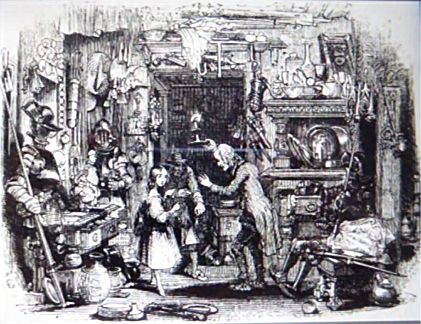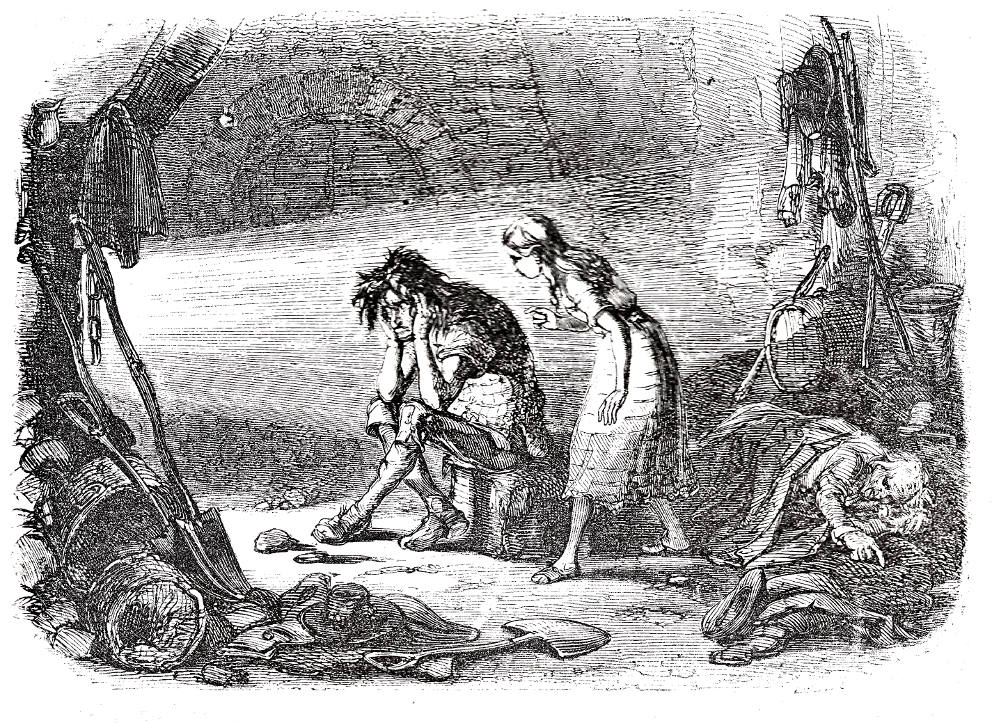
Note: I’ve found this hard to write about without giving away some spoilers.
I’d listed The Old Curiosity Shop in my Classics Club Spin, but was really hoping to get one of Thomas Hardy’s books. Without this push from the Classics Club this book would have stayed on my TBR list for a long time because all I knew about it was that it’s the book in which Little Nell suffers a melodramatic death and I feared it would be too sentimental for my liking. And much to my surprise I have finished it in time for the deadline for reading our Spin book this Friday, even though it’s such a long book.
Well, it was and it wasn’t. It’s not just a sentimental, melodramatic story. It’s also full of weird, grotesque and comic characters, a mix of everyday people and characters of fantasy. It has elements of folklore and myth, as Nell and her grandfather, go on an epic journey, fleeing from the terrifying dwarf, Daniel Quilp and travelling through a variety of scenes, meeting different groups of people on their journey. There are numerous allusions to the Bible, Shakespeare and popular songs of the day. There are long passages where Nell doesn’t feature and is hardly mentioned, so it’s by no means a totally sentimental tale.
Several of the characters stand out for me, Quilp is an obvious choice. He takes delight in inflicting pain and suffering on others. He’s scarcely human, grossly wicked, hideous in appearance, full of lust, ferocious, cunning, and malicious. A fiend who
… ate hard eggs, shell and all, devoured gigantic prawns with heads and tails on, chewed tobacco and water-cresses at the same time and with extraordinary greediness, drank boiling tea without winking, bit his fork and spoon until they bent again, and in short performed so many horrifying and uncommon acts that the women were nearly frightened out of their wits, and began to doubt if he were really a human creature. (page 47)
Other characters who stood out are Dick Swiveller and the Marchioness. Dick at first appears as a profligate friend of Nell’s brother, Fred but takes on a larger role later in the book. Working in a law office for Mr Brass and his sister, Sally Brass, he befriends the small, half-starved girl who is a servant locked in the basement, calling her the Marchioness. He rescues her and also Kit, Nell’s friend, when he is wrongly accused of robbery.
There are many more I could mention, including the people Nell and her grandfather meet on their travels – wonderful scenes of the travelling Punch and Judy show; Mrs Jarley’s wax-work figures, over a hundred of them that she takes around the countryside in a caravan; the gypsies who take advantage of Nell’s grandfather’s addiction to gambling; the poor schoolteacher who take in Nell and her grandfather; and the Bachelor who they meet at the end of their journey.
I also liked the description of the landscape as Nell leaves London, the change from town to countryside, then later through the industrial Midlands with its factories, furnaces and roaring steam-engines where people worked in terrible conditions. Nell and her grandfather spend a night in one of the furnaces, sleeping on a heap of ashes.
In a large and lofty building, supported by pillars of iron, with great black apertures in the upper walls, open to the external air; echoing to the roof with the beating of hammers and roar of furnaces, mingled with the hissing of red-hot metal plunged in water, and a hundred strange unearthly noises never heard elsewhere; in this gloomy place, moving like demons among the flame and smoke, dimly and fitfully seen, flushed and tormented by the burning fires, and wielding great weapons, a faulty blow from any one of which must have crushed some workman’s skull, a number of men laboured like giants. (pages 334-5)
Nell, herself, is a sweet, self-effacing and innocent character, who is left to look after her grandfather as he fails to overcome his gambling addiction. She goes into a decline and her slow death is, I suppose inevitable, although thankfully it is not described by Dickens. Child death is one of the themes of The Old Curiosity Shop as Nell’s death is not the only one.
The Old Curiosity Shop was written in 1840 – 1841 and serialised weekly in Master Humphrey’s Clock beginning on 4 April 1840 and ending on 6 February 1841. During this period the circulation of the periodical rose to a staggering figure of 100,000. It was Dickens’ fourth novel, influenced by the early death of his sister-in-law, Mary Hogarth, in 1837, which had profoundly shocked him. His work on The Old Curiosity Shop, particularly as he came to writing the end, revived the anguish he had experienced on her death.

I read the Penguin Classics e-book which has the original illustrations by George Cattermole, Hablot K Browne (‘Phiz’), Daniel
Maclise and Samuel Williams.

Despite the sentimentality I did enjoy reading The Old Curiosity Shop and it has made me keen to read more of Dickens’ books.
As well as being my Classics Club Spin, this book also qualifies for the Mount To Be Read Challenge and the Victorian Bingo Challenge.
going back to Dickens for the first time in ages I have been reminded just what a remarkable story teller he is. He picks you up and spins you off into the centre of the tale before you know what’s hit you and you are caught in that ‘just one more chapter’ trap. I made the mistake of starting ‘Bleak House’ this morning and have been incommunicado for most of the rest of the day.
LikeLike
I haven’t read many of Dickens’ books, but Bleak House is one of them. I read it years ago after watching a TV version with Charles Dance as Mr Tulkinghorn. I loved it. Because I have long gaps between reading his books I’m always surprised by how readable they are. I’m thinking I need to start another one soon.
LikeLike
This is one I thought I had read but now realise from your description that I haven’t – must rectify that! I can always put up with Dickens’ sentimentality because it’s usually only a small part of the story, and I love his descriptive writing and quirky characters so much.
LikeLike
I know just what you mean about thinking you’ve read a book, only to realise that you haven’t. I’m not all sure whether I’ve read David Copperfield and Oliver Twist – maybe because I ‘know’ the story from watching films and TV and the characters are so memorable.
LikeLike
You know… I too thought I’d read this *years* ago but none of that sounds familiar at all. It sounds much better than I remember in fact, so I rather think I shall have a go at reading it at some stage. Excellent review, Margaret!
LikeLike
Thanks, Cath. I see there is an adaptation is in production by the BBC, for broadcast in the UK at Christmas 2015 – I’m not sure whether to watch it as I don’t want to get different images in my mind, but I think it could be quite spectacular.
LikeLike
Very glad to hear you enjoyed this, Margaret. I think Dickens tells such an excellent story that the sentimentality doesn’t overtake it – at least for me. And I’ve always liked both his characters and the writing style.
LikeLike
I agree Margot – the sentimentality was only a part of this book and not a very large part either. And the characters are fantastic.
LikeLike
I read Bleak House for an earlier Spin, & like you, surprised myself by how much I enjoyed it…even the sentimental bits 🙂
LikeLike
Yes, Brona – the sentimental bits weren’t as sickly sweet as I thought they’d be.
LikeLike
Isn’t it interesting how books that are often dreaded (for whatever reason) turn out to be more enjoyable than expected? I read this more than 20 years ago at a time when I was not really into Dickens and have not fond memories, or many memories for that matter, of it. Now, reading your review and having read more of Dickens as well as more about him, I’m curious to revisit this book.
Your quote describing the devilish Quilip is wonderful in and of itself.
Great post!
LikeLike
Jane, Little Dorrit is one of his books that I’m not expecting to like much – but that may be because I began watching the TV version a few years ago and gave up! I think it could be my next Dickens to read. I do hope you’ll enjoy The Old Curiosity Shop if you do revisit it. Quilp is an amazing character.
LikeLike
Well, not my favorite Dickens, but it sounds like you enjoyed it.
LikeLike